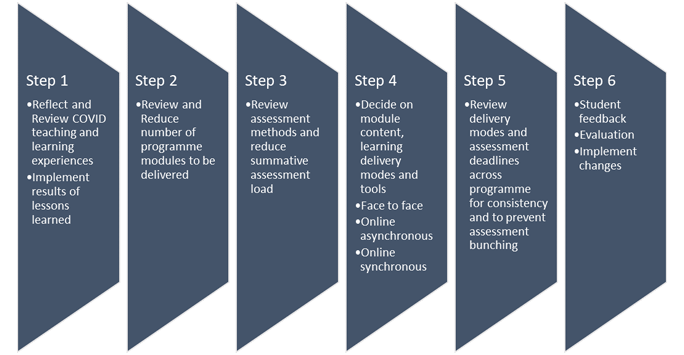A full suite of guidance is available in the CIE Hybrid Active Learning Support Canvas Resource. Many of the links within this document are to pages within the Canvas course, so when you click on a link here it will take you to the University verification page to log in first. After you have logged in you will automatically be redirected to the Canvas course.

Step 1
Reflect on the immediate urgent changes you made to teaching delivery, assessment and student support between March 20 and July 20 during lock down. What went well, what didn’t and how did students react to the changes you put in place?
Use the lessons learned to help you plan for 20/21 delivery.
Step 2
Review your programme modules/ programme components (PC) - are there any you can’t run due to practical reasons? (i.e. field trips abroad, inability to social distance whilst completing certain essential tasks, staff shielding etc.) Take these out of the offering for the new academic year.
If your programme has a lot of optional modules/PCs consider removing some options to make delivery easier- staff will find it beneficial to work in teaching teams where possible to spread the teaching, marking and student support load and take into account potential staff illness/ extra student support required.
Step 3
Consider the assessment methods for the modules you are going to deliver. Bear in mind face to face assessment on campus is highly unlikely to be an option under current restrictions. Consider your assessment options in terms of integrity, how “cheat proof” is your assessment in the online environment? How or can you deliver it? Consider your available options: CIE Assessment and Academic Integrity Guide.
Review the current assessments to ensure they measure the module/ PC learning outcomes. If you have multiple assessments that measure similar knowledge and skills remove duplicate assessments. If you can reduce summative assessment load do so.
Lastly consider your assessment in terms of the behaviour it will inspire in students, what do you want them to do? If you want them to work in groups you need to set group work as an assessment, if you want them to complete exercises around lecture content add an assessment value to it etc.
If you want to make changes to your assessment these will need to go through the School Scrutiny Panel using the AQSD new light touch approval process. Speak to your Curriculum Board or School Scrutiny Panel Chair for details of this. Decisions will be made at SSP rather than requiring review at FAQSC and UAP.
Step 4
Consider how you are going to deliver learning and teaching during your modules/PC using the following 3 modes:
- Face to Face on Campus.
- Online Synchronous (live interactive sessions between staff/ students or students and their peers for example on Zoom, in MS Teams or Canvas).
- Online Asynchronous (pre-recorded/ pre-populated learning materials available on canvas or VITAL site that students view/ work through independently at times convenient to them).
When deciding which content to deliver and how consider the following:
- Face to Face time on campus will be limited. Current group sizes (July 2020) are calculated at 20-25, with a possibility of combining two groups in specific circumstances/ locations. Therefore, only use face to face sessions for high value learning activities. CIE have modelled suggestions for learning activities around the ABC Learning Design model and ABC Learning Types. We would recommend that face to face contact is reserved for collaborative/ practice/ production-based activities. View Collaboration definitions.
- Online Synchronous activity should be used for activities that require interaction between staff and students and/or students and their peers. These include tutorials, Academic Advisor Meetings, Academic Support Drop Ins or Meetings and activities that require discussion and/ or collaboration.
- Online Asynchronous activity should consist of mainly acquisition based learning, such as watching a pre-recorded lecture, reading papers or textbook extracts etc. Active work can also take place asynchronously, such as group discussions or tasks (develop a group poster/ presentation/ product etc.) This just needs to be planned and further time allowed to complete the activities.
Question. Why is it better to pre-record lectures that deliver them asynchronously?
Answer. For access and inclusion purposes. Some of our students will not be returning to Campus from overseas and be in different time zones, some may be required to look after siblings. Not all students have access to their own laptop and may need to share a family owned device, when convenient to others, some may be home-schooling children. In the same way COVID impacts on all our lives it is the same for students.
Question. I don’t know how to run group activities online, or what tools to use where can I go for help?
Answer. CIE has made a Canvas resource to support staff. There are specific pages with suggestions of how to turn a face to face activity into one appropriate for asynchronous or synchronous online delivery and which tools to use to deliver these. Teaching examples per mode with tool requirements. Guides on how to use the tools are also available: Overview of Digital Tools.
Step 5
Communicate with other Module Leads and your Programme Lead to ascertain if there are School wide or Programme Wide guidelines regarding hybrid delivery. Discuss consistency in approach across the programme (not every module has to do the same but student workload/ contact hours should be consistent between modules of equal weighting). Also ensure assessment deadlines do not all take place at the same point within modules that run concurrently to avoid assessment bunching which is stressful for students.
Step 6
Remember to use evaluation strategies to monitor how your programme delivery is being experienced by students (and staff) and be ready to make changes in light of student feedback.

CIE Quick Start Guide to Implementing Hybrid Active Learning by Ceridwen Coulby is licensed under a Creative Commons Attribution-NonCommercial 4.0 International License.